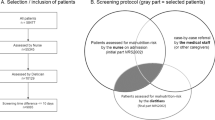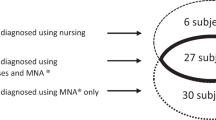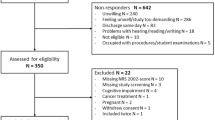Abstract
Objectives
To evaluate the validity and reproducibility of StrongKids as a pediatric nutritional screening tool in Brazil, which has no validated method for this purpose.
Methods
A cross-sectional study was conducted with 641 patients admitted to the pediatric care unit of a public hospital from 2014 to 2018. The concurrent validity was assessed by evaluating the sensitivity, specificity, and the positive and negative predictive values of StrongKids in detecting acute, chronic, and overall malnutrition. Predictive validity was determined by calculating the same indices to identify longer than median hospital stay, need of enteral nutrition, 30-day hospital readmission, transfer to hospitals with more complex procedures, and death. StrongKids was reapplied to a subsample to evaluate the inter-rater reproducibility.
Results
Prevalence of low risk was 15.6%, moderate risk was 63.7%, and high nutritional risk was 20.7%. A positive test, corresponding to the moderate or high risk category, identified all those with acute malnutrition and showed sensitivity of 89.4% (95% CI: 76.9–96.4) and 94.0% (95% CI: 86.6–98.0) for the detection of chronic and overall malnutrition, respectively. Regarding its predictive capacity, 100% of the patients who needed enteral nutrition, who were transferred, died, or were readmitted to hospital within 30 days after discharge were considered in risk by StrongKids, and the sensitivity to identify those with prolonged hospital stays was 89.2 (95% CI: 84.6–92.7). The inter-rater agreement was excellent (PABAK: 0.87).
Conclusions
StrongKids had satisfactory validity and reproducibility and successfully identified nutritional deficits and predict unfavorable health outcomes. Our results support the use of StrongKids as a pediatric nutritional risk screening method in Brazil.
This is a preview of subscription content, access via your institution
Access options
Subscribe to this journal
Receive 12 print issues and online access
$259.00 per year
only $21.58 per issue
Buy this article
- Purchase on Springer Link
- Instant access to full article PDF
Prices may be subject to local taxes which are calculated during checkout
Similar content being viewed by others
References
Joosten KFM, Hulst JM. Prevalence of malnutrition in pediatric hospital patients. Curr Opin Pediatr. 2008;20:590–6.
Prado RCG, Santos PFB, Assis EM, Zaban ALRS. Malnutrition and subjective nutritional assessment in pediatrics. Comun Ciênc Saúde. 2010;21:61–70.
Saunders J, Smith T. Malnutrition: causes and consequences. Clin Med. 2010;10:624–7.
Hecht C, Weber M, Grote V, Daskalou E, Dell’Era L, Flynn D, et al. Disease associated malnutrition correlates with length of hospital stay in children. Clin Nutr. 2015;34:53–9.
Kondrup J, Allison SP, Elia M, Vellas B, Plauth M. ESPEN guidelines for nutrition screening 2002. Clin Nutr. 2003;22:415–21.
Cederholm T, Barazzoni R, Austin P, Ballmer P, Biolo G, Bischoff SC, et al. ESPEN guidelines on definitions and terminology of clinical nutrition. Clin Nutr. 2017;36:49–64.
McCarthy A, Delvin E, Marcil V, Belanger V, Marchand V, Boctor D, et al. Prevalence of malnutrition in pediatric hospitals in developed and in-transition countries: the impact of hospital practices. Nutrients. 2019;11:236.
Durá-Travé T, San Martin-García I, Gallinas-Victoriano F, Vaquero Iñigo I, González-Benavides A. Prevalence of malnutrition in hospitalised children: retrospective study in a Spanish tertiary-level hospital. J R Soc Med. 2016;7:1–8.
Hulst JM, Zwart H, Hop WC, Joosten KFM. Dutch national survey to test the STRONGkids nutritional risk screening tool in hospitalized children. Clin Nutr. 2010;29:106–11.
Ling RE, Hedges V, Sullivan PB. Nutritional risk in hospitalised children: an assessment of two instruments. e-SPEN Eur e-J Clin Nutr Metab. 2011;6:e153–7.
Joosten KFM, Hulst JM. Nutritional screening tools for hospitalized children: methodological considerations. Clin Nutr. 2014;33:1–5.
Carvalho FC, Lopes CR, Vilela L, da C, Vieira MA, Rinaldi AEM, et al. Translation and cross-cultural adaptation of the Strongkids tool for screening of malnutrition risk in hospitalized children. Rev Paul Pediatr. 2013;31:159–65.
Teixeira AF, Viana KDAL. Nutritional screening in hospitalized pediatric patients: a systematic review. J Pediatr. 2016;92:343–52.
Santos CA, Ribeiro AQ, Rosa COB, Araújo VE, Franceschini SCC. Nutritional risk in pediatrics by StrongKids: a systematic review. Eur J Clin Nutr. 2018. https://doi.org/10.1038/s41430-018-0293-9.
Jones JM. Validity of nutritional screening and assessment tools. Nutrition. 2004;20:312–7.
Huysentruyt K, Alliet P, Muyshont L, Rossignol R, Devreker T, Bontems P, et al. The STRONGkids nutritional screening tool in hospitalized children: a validation study. Nutrition. 2013;29:1356–61.
Bujang MA, Baharum N. Guidelines of the minimum sample size requirements for Kappa agreement test. Epidemiol Biostat Public Health. 2017;14:e12267-1–10.
Brasil. Orientações para a coleta e análise de dados antropométricos em serviços de saúde: Norma Técnica do Sistema de Vigilância Alimentar e Nutricional—SISVAN. Brasília: Ministério da Saúde, Secretaria de Atenção à Saúde, Departamento de Atenção Básica; 2011. http://bvsms.saude.gov.br/bvs/publicacoes/orientacoes_coleta_analise_dados_antropometricos.pdf. Accessed Feb 10, 2014.
WHO Multicentre Growth Reference Study Group. The WHO child growth standards. 2006. http://www.who.int/childgrowth/en/. Accessed Jan 8, 2015.
WHO Multicentre Growth Reference Study Group. Growth reference data for 5–19 years. 2007. http://www.who.int/growthref/en/. Accessed Jan 8, 2015.
WHO. Management of severe malnutrition: a manual for physicians and other senior health workers. Geneva: World Health Organization; 1999.
Song T, Mu Y, Gong X, Ma W, Li L. Screening for nutritional risk in hospitalized children with liver disease. Asia Pac J Clin Nutr. 2017;26:1107–12.
Landis JR, Koch GG. The measurement of observer agreement for categorical data. Biometrics. 1977;33:159.
Moeeni V, Walls T, Day AS. Assessment of nutritional status and nutritional risk in hospitalized Iranian children. Acta Paediatr. 2012;101:446–51.
Cao J, Peng L, Li R, Chen Y, Li X, Mo B, et al. Nutritional risk screening and its clinical significance in hospitalized children. Clin Nutr. 2014;33:432–6.
Bang YK, Park MK, Ju YS, Cho KY. Clinical significance of nutritional risk screening tool for hospitalised children with acute burn injuries: a cross-sectional study. J Hum Nutr Diet. 2017;31:370–8.
Beser OF, Cokugras FC, Erkan T, Kutlu T, Yagci RV, Ertem D, et al. Evaluation of malnutrition development risk in hospitalized children. Nutrition. 2018;48:40–7.
Márquez Costa MV, Alberici Pastore C. Nutritional screening tool versus anthropometric assessment in hospitalized children: which method is better associated to clinical outcomes? Arch Latinoam Nutr. 2015;65:12–20.
Moeeni V, Walls T, Day AS. Nutritional status and nutrition risk screening in hospitalized children in New Zealand. Acta Paediatr. 2013;102:e419–23.
Chourdakis M, Hecht C, Gerasimidis K, Joosten KFM, Karagiozoglou-Lampoudi T, Koetse HA, et al. Malnutrition risk in hospitalized children: use of 3 screening tools in a large European population. Am J Clin Nutr. 2016;103:1301–10.
Leppin AL, Gionfriddo MR, Kessler M, Brito JP, Mair FS, Gallacher K, et al. Preventing 30-day hospital readmissions: a systematic review and meta-analysis of randomized trials. JAMA Intern Med. 2014;174:1095–107.
Berry JG, Gay JC, Joynt Maddox K, Coleman EA, Bucholz EM, O’Neill MR, et al. Age trends in 30 day hospital readmissions: US national retrospective analysis. BMJ. 2018;360:k497.
Syed MH, Hussain MA, Khoshhal Z, Salata K, Altuwaijri B, Hughes B, et al. Thirty-day hospital readmission and emergency department visits after vascular surgery: a Canadian prospective cohort study. Can J Surg. 2018;61:257–63.
Cederholm T, Bosaeus I, Barazzoni R, Bauer J, Van Gossum A, Klek S, et al. Diagnostic criteria for malnutrition—an ESPEN Consensus Statement. Clin Nutr. 2015;34:335–40.
Charney P. Nutrition screening vs nutrition assessment: how do they differ? Nutr Clin Pract. 2008;23:366–72.
Mueller C, Compher C, Ellen DM. A.S.P.E.N. clinical guidelines: nutrition screening, assessment, and intervention in adults. J Parenter Enter Nutr. 2011;35:16–24.
Ortíz-Gutiérrez S, Pérez-Cruz E, Lara-Pompa NE, Serralde-Zúñiga AE, Fewtrell M, Peralta-Pedrero ML, et al. Validation and adaptation of the Spanish Version of the STRONGkids nutrition screening tool. Nutr Clin Pract. 2019;34:589–96.
Galera-Martínez R, Moráis-López A, Rivero De La Rosa MD, Escartn-Madurga L, López-Ruzafa E, Ros-Arnal I, et al. Reproducibility and inter-rater reliability of 2 paediatric nutritional screening tools. J Pediatr Gastroenterol Nutr. 2017;64:e65–70.
Moeeni V, Walls T, Day AS. The STRONGkids nutritional risk screening tool can be used by paediatric nurses to identify hospitalised children at risk. Acta Paediatr. 2014;103:e528–31.
Mustapha M, Callan J, Champion H, Radbone L. Making the best use of a hospital Dietitian. Paediatr Child Health. 2013;23:342–5.
Skipper A, Ferguson M, Thompson K, Castellanos VH, Porcari J. Nutrition screening tools: an analysis of the evidence. J Parenter Enter Nutr. 2012;36:292–8.
Acknowledgements
The authors gratefully acknowledge all the participating children and their parents/caregivers, as well the doctors and nurses of the pediatric unit of São Sebastião Hospital. We also thank the participating students AL Wendling, LO Possa, and AP Floriano.
Author information
Authors and Affiliations
Contributions
The authors worked on the following stages: CAS: conceptualization; methodology; formal analysis; investigation; writing. COBR: conceptualization; methodology; writing. SCCF: conceptualization; methodology; writing. JSC: formal analysis; investigation. IBMC: formal analysis; investigation. HHF: methodology; resources; writing. AQR: conceptualization; methodology; formal analysis; reviewing and editing. All authors have read and approved the final version of the paper.
Corresponding author
Ethics declarations
Conflict of interest
The authors declare that they have no conflict of interest.
Additional information
Publisher’s note Springer Nature remains neutral with regard to jurisdictional claims in published maps and institutional affiliations.
Rights and permissions
About this article
Cite this article
Santos, C.A.d., Rosa, C.d.O.B., Franceschini, S.d.C.C. et al. StrongKids for pediatric nutritional risk screening in Brazil: a validation study. Eur J Clin Nutr 74, 1299–1305 (2020). https://doi.org/10.1038/s41430-020-0644-1
Received:
Revised:
Accepted:
Published:
Issue Date:
DOI: https://doi.org/10.1038/s41430-020-0644-1



